-63 bytes thanks to @Arnauld. Wow.
n=>(E=(x,y,d,k,h)=>V[k=[x+=1-(d%=3),y+=~d%3+1,d]]?0:(V[k]=1,h=H.find(h=>h[0]==x&h[1]==y))?(d^(t=2-h[2])?E(x,y,t)||E(x,y,h[2]*2):E(x,y,t+2)):[x,y,0],I=c=>c.map(([x,y,t])=>[x-g(0),y-g(1),t],g=p=>Math.min(...c.map(h=>h[p]))).sort(),S=e=>(V={},e=E(0,0,0))?(--n&&H.pop(H.push(e),S(),S(e[2]=1),S(e[2]=2)),++n):n-1||E[I(c=H)]||[0,0,0,++N,0,0].map(r=>E[I(c=c.map(([x,y,t])=>[-x-y,r?y:x,(r?t*2:t+1)%3]))]=1))(H=[[N=0,0,1]])&&N
Try it online!
Firstly, repect to Arnauld whose answer gave me the inspiration to dig deeper. I have tried hard to be original with my algorithms, although I intentionally changed some of my code to use the same variables as Arnauld so that the code could be more easily compared.
Searching for empty hexes
The search for creatures is:
- Initialize list of tiles with tile 1 at 0,0
- Recursively:
- Search for an empty hex that is needed to complete creature
- If empty hex found
- Add each type of tile 0,1,2 to empty hex and recurse
- If empty hex not found
- If creature is of correct size and is not already in zoo
- Increment number of distinct creatures found by one
- Add all rotations and reflections of creature to zoo
The search for empty hexes uncovered an interesting symmetry. Arnauld discovered that one of the six directions could be ignored, but in fact three out of six can be ignored!
Here is Arnauld's original direction and tile key:
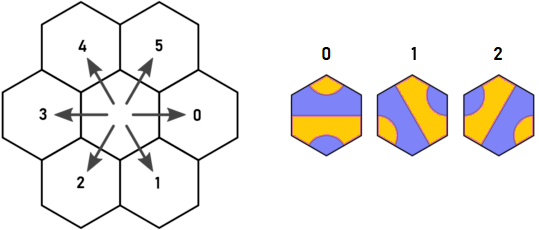
Imagine we start at tile A of type 1 at the blue dot. It seems that we have to recurse out in d=0 and d=5. However, whichever tile is placed in d=0, it will certainly have an exit in d=4, which will visit the same hex as exiting tile A in d=5. That is Arnauld's discovery, and it's what started me thinking.
Notice that:
This means that we only need to consider directions 0,2,4. Any exits in directions 1,3,5 can be
ignored because the hexes reachable in directions 1,3,5 can instead be reached from an adjacent hex
using directions 0,2 or 4.
How cool is that!?
Relabelled Directions
So I relabel the directions and tiles like this (Arnauld's image edited):
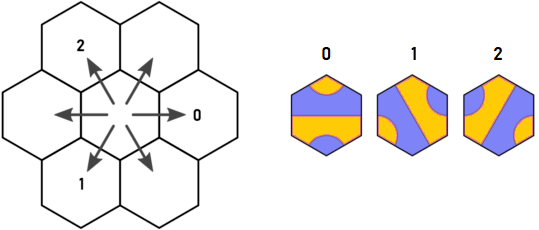
Now we have the following relationship between tiles, entries and exits:
| t=0 | t=1 | t=2
----+-------+-------+-------
d=0 | 0,2 | 1,2 | 2
d=1 | 0,2 | 0 | 0,1
d=2 | 1 | 1,2 | 0,1
So exits are: d+t==2 ? (4-t)%3 : 2-t and 2*t%3
Hexagonal Rotations and Reflections
For rotations and reflections, I decided to try x,y hexagonal axial coordinates instead of the x,y,z cube coordinates.
-1,2 0,2 1,2 2,2
0,1 1,1 2,1
0,0 1,0 2,0 3,0
In this system, the rotation and reflection were simpler than I expected:
120 Rotation: x=-x-y y=x t=(t+1)%3
Reflection: x=-x-y y=y t=(t*2)%3
To get all the combinations I performed : rot,rot,rot,reflect,rot,rot
Code (Original 480 byte)
f=n=>(
// H:list of filled hexes [x,y,tile] during search for a complete creature
// N:number of distinct creatures of size n
// B:record of all orientations of all creatures already found
H=[[0,0,1]],N=0,B={},
// E: find an empty hex required to complete creature starting in direction d from x,y
E=(x,y,d,k,h)=>(
x+=1-d,
y+=1-(d+1)%3,
// V: list of visited hexes during this search in E
V[k=[x,y,d]] ?
0
: (V[k]=1, h=H.find(h=>h[0]==x&&h[1]==y)) ?
// this hex is filled, so continue search in 1 or 2 directions
(d==2-h[2] ? E(x,y,(4-h[2])%3) : (E(x,y,2-h[2]) || E(x,y,h[2]*2%3)))
: [x,y,0] // return the empty hex
),
// I: construct unique identifier for creature c by moving it so x>=0 and y>=0
I=c=>(
M=[0,1].map(p=>Math.min(...c.map(h=>h[p]))),
c.map(([x,y,t])=>[x-M[0],y-M[1],t]).sort()
),
// A: add complete creature c to B
A=c=>{
n==1&&!B[I(c)]&&(
// creature is correct size and is not already in B
N++,
[0,0,0,1,0,0].map(
// Add all rotations and reflections of creature into B
// '0' marks a rotation, '1' marks a (vertical) reflection
// rotation: x=-x-y y=x t=(t+1)%3
// reflection: x=-x-y y=y t=(t*2)%3
r=>B[I(c=c.map(([x,y,t])=>[-x-y,r?y:x,(r?t*2:t+1)%3]))]=1)
)
},
// S: recursively search for complete creatures starting with hexes H
S=e=>{
V={};
(e=E(0,0,0)) ?
// e is a required empty hex, so try filling it with tiles 0,1,2
(--n && (H.push(e),S(),S(e[2]=1),S(e[2]=2),H.pop()), ++n)
: A(H) // creature is complete, so add it to B
},
S(),
N
)
Code (Arnauld 417 byte)
Arnauld kindly submitted a 63 byte saving that used tricks that took me quite some time to wrap my head around. Since it has many interesting edits, I thought I'd put his code below (I've added my comments) so that it can be contrasted with my version.
f=n=>(
// E:find an empty hex required to complete creature starting in direction d from x,y
E=(x,y,d,k,h)=>
V[k=[x+=1-(d%=3),y+=~d%3+1,d]] ?
0
:(V[k]=1,h=H.find(h=>h[0]==x&h[1]==y)) ?
(d^(t=2-h[2]) ? E(x,y,t) || E(x,y,h[2]*2) : E(x,y,t+2))
:[x,y,0],
// I: construct unique identifier for creature c by moving it so x>=0 and y>=0
I=c=>c.map(([x,y,t])=>[x-g(0),y-g(1),t],g=p=>Math.min(...c.map(h=>h[p]))).sort(),
// S: recursively search for complete creatures starting with hexes H
S=e=>
(V={},e=E(0,0,0)) ?
(--n&&H.pop(H.push(e),S(),S(e[2]=1),S(e[2]=2)),++n)
:n-1
||E[I(c=H)]
// creature is the correct size and has not been seen before
// so record all rotations and reflections of creature in E[]
||[0,0,0,++N,0,0].map(r=>E[I(c=c.map(([x,y,t])=>[-x-y,r?y:x,(r?t*2:t+1)%3]))]=1)
)
// This wonderfully confusing syntax initializes globals and calls S()
(H=[[N=0,0,1]]) && N
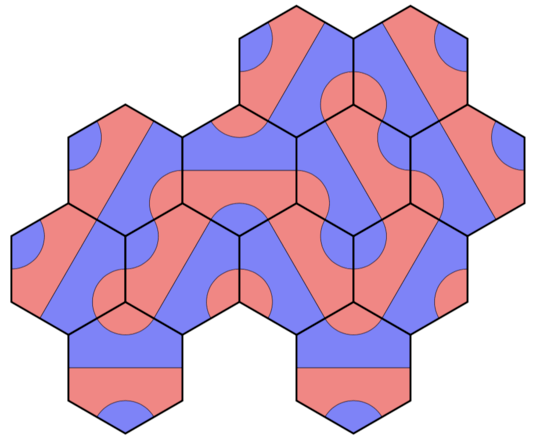
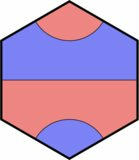


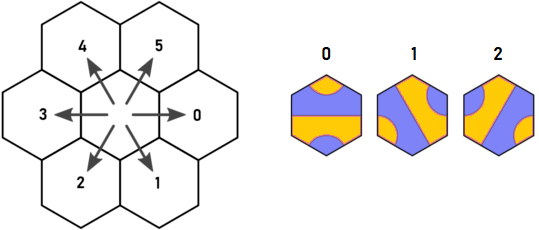
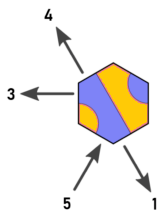
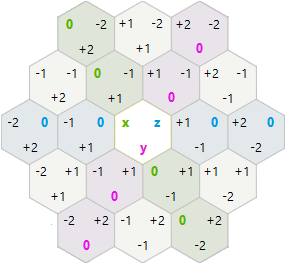

"The program should be able to handle up to
n=10on TIO." -- if that is an execution speed requirement, please use [tag:code-challenge] instead of [tag:code-golf], the latter referring to a pure byte optimization task. – Jonathan Frech – 2019-09-17T18:02:04.56010
Based on the discussion here, it looks like it's okay to have an execution speed requirement in a [tag:code-golf] question, as long as the scoring is number of bytes.
– Peter Kagey – 2019-09-17T18:06:26.3572+1 Just like a spiral sequence, this challenge is easy to understand and really interesting to solve ... but requires quite a bit of code. :p – Arnauld – 2019-09-18T14:13:56.893
1So.... we're just taking an input and returning the output from the list above, for n between 1 and 10? Can I just use a lookup table? – BradC – 2019-09-18T16:23:18.110
6
@BradC This is a default loophole. The OP just said that solutions should be able to handle up to $n=10$ on TIO.
– Arnauld – 2019-09-18T16:57:20.140